Null mutation of c-fos causes exacerbation of methamphetamine-induced neurotoxicity
- PMID: 10559418
- PMCID: PMC6782995
- DOI: 10.1523/JNEUROSCI.19-22-10107.1999
Null mutation of c-fos causes exacerbation of methamphetamine-induced neurotoxicity
Abstract
Methamphetamine neurotoxicity has been demonstrated in rodents and nonhuman primates. These neurotoxic effects may be associated with mechanisms involved in oxidative stress and the activation of immediate early genes (IEG). It is not clear, however, whether these IEG responses are involved in a methamphetamine-induced toxic cascade or in protective mechanisms against the deleterious effects of the drug. As a first step toward clarifying this issue further, the present study was thus undertaken to assess the toxic effects of methamphetamine in heterozygous and homozygous c-fos knock-out as well as wild-type mice. Administration of methamphetamine caused significant reduction in [(125)I]RTI-121-labeled dopamine uptake sites, dopamine transporter protein, and tyrosine hydroxylase-like immunohistochemistry in the striata of wild-type mice. These decreases were significantly exacerbated in heterozygous and homozygous c-fos knock-out mice, with the homozygous showing greater loss of striatal dopaminergic markers. Moreover, in comparison with wild-type animals, both genotypes of c-fos knock-out mice showed more DNA fragmentation, measured by the number of terminal deoxynucleotidyl transferase-mediated dUTP nick-end-labeled nondopaminergic cells in their cortices and striata. In contrast, wild-type mice treated with methamphetamine demonstrated a greater number of glial fibrillary acidic protein-positive cells than did c-fos knock-out mice. These data suggest that c-fos induction in response to toxic doses of methamphetamine might be involved in protective mechanisms against this drug-induced neurotoxicity.
Figures


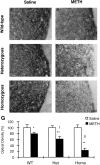
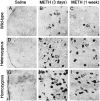
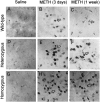
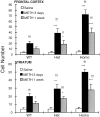
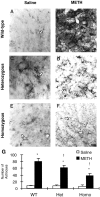

References
-
- Albers DS, Sonsalla PK. Methamphetamine-induced hyperthermia and dopaminergic neurotoxicity in mice: pharmacological profile of protective and nonprotective agents. J Pharmacol Exp Ther. 1995;275:1104–1114. - PubMed
-
- Ali SF, Newport GD, Holson RR, Slikker W, Jr, Bowyer JF. Low environmental temperatures or pharmacologic agents that produce hypothermia decrease methamphetamine neurotoxicity in mice. Brain Res. 1994;658:33–38. - PubMed
-
- Asanuma M, Cadet JL. Methamphetamine-induced increase in striatal NF-kappaB DNA-binding activity is attenuated in superoxide dismutase transgenic mice. Brain Res Mol Brain Res. 1998;60:305–309. - PubMed
-
- Asanuma M, Hirata H, Cadet JL. Attenuation of 6-hydroxydopamine-induced dopaminergic nigrostriatal lesions in superoxide dismutase transgenic mice. Neuroscience. 1998;85:907–917. - PubMed
-
- Baba T, Yamamda H, Oguri K, Yoshimura H. Participation of cytochrome P-450 isozymes in N-demethylation, N-hydroxylation and aromatic hydroxylation of methamphetamine. Xenobiotica. 1988;18:475–484. - PubMed
MeSH terms
Substances
LinkOut - more resources
Full Text Sources
Medical
Molecular Biology Databases
Research Materials
